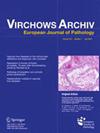恶性上皮样肿瘤,伴有 GLI1 基因重排(PANX3::GLI1 转录本)和 MDM2 基因扩增。
IF 3.4
3区 医学
Q1 PATHOLOGY
引用次数: 0
摘要
我们在此报告一例13岁儿童翼腭窝上皮样肿瘤病例,该肿瘤携带PANX3::GLI1融合基因和MDM2扩增基因。鉴定出的嵌合基因可以解释观察到的成骨分化迹象。我们讨论了与成骨性肿瘤和具有上皮样形态的软组织肿瘤进行鉴别诊断所面临的挑战。我们的病例是首次报道具有此类基因异常的肿瘤,它将补充罕见的GLI1重组肿瘤的谱系。本文章由计算机程序翻译,如有差异,请以英文原文为准。
Malignant epithelioid neoplasm with GLI1 gene rearrangement (PANX3::GLI1 transcript) and MDM2 gene amplification.
We hereby report the case of an epithelioid neoplasm arising from pterygopalatine fossa in a 13-year-old child harboring PANX3::GLI1 fusion and MDM2 amplification. Identified chimeric gene can explain observed signs of osteogenic differentiation. We discuss the challenges in differential diagnosis from osteogenic tumors and soft tissue neoplasms with epithelioid morphology. Our case is the first report of a tumor with such genetic abnormalities and it is about to replenish the spectrum of rare GLI1-rearranged tumors.
求助全文
通过发布文献求助,成功后即可免费获取论文全文。
去求助
来源期刊

Virchows Archiv
医学-病理学
CiteScore
7.40
自引率
2.90%
发文量
204
审稿时长
4-8 weeks
期刊介绍:
Manuscripts of original studies reinforcing the evidence base of modern diagnostic pathology, using immunocytochemical, molecular and ultrastructural techniques, will be welcomed. In addition, papers on critical evaluation of diagnostic criteria but also broadsheets and guidelines with a solid evidence base will be considered. Consideration will also be given to reports of work in other fields relevant to the understanding of human pathology as well as manuscripts on the application of new methods and techniques in pathology. Submission of purely experimental articles is discouraged but manuscripts on experimental work applicable to diagnostic pathology are welcomed. Biomarker studies are welcomed but need to abide by strict rules (e.g. REMARK) of adequate sample size and relevant marker choice. Single marker studies on limited patient series without validated application will as a rule not be considered. Case reports will only be considered when they provide substantial new information with an impact on understanding disease or diagnostic practice.
 求助内容:
求助内容: 应助结果提醒方式:
应助结果提醒方式:


